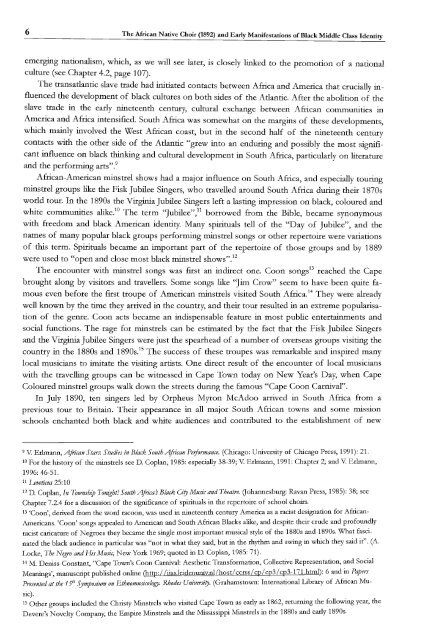South African Choral Music (Amakwaya): Song, Contest and the ...
South African Choral Music (Amakwaya): Song, Contest and the ...
South African Choral Music (Amakwaya): Song, Contest and the ...
Create successful ePaper yourself
Turn your PDF publications into a flip-book with our unique Google optimized e-Paper software.
6 The Mrican Native Choir (1892) <strong>and</strong> Early Manifestations of Black Middle Class Identity<br />
emerging nationalism, which, as we will see later, is closely linked to <strong>the</strong> promotion of a national<br />
culture (see Chapter 4.2, page 107).<br />
The transatlantic slave trade had initiated contacts between Africa <strong>and</strong> America that crucially influenced<br />
<strong>the</strong> development of black cultures on both sides of <strong>the</strong> Atlantic. After <strong>the</strong> abolition of <strong>the</strong><br />
slave trade in <strong>the</strong> early nineteenth century, cultural exchange between <strong>African</strong> communities in<br />
America <strong>and</strong> Africa intensified. <strong>South</strong> Africa was somewhat on <strong>the</strong> margins of <strong>the</strong>se developments,<br />
which mainly involved <strong>the</strong> West <strong>African</strong> coast, but in <strong>the</strong> second half of <strong>the</strong> nineteenth century<br />
contacts with <strong>the</strong> o<strong>the</strong>r side of <strong>the</strong> Atlantic "grew into an enduring <strong>and</strong> possibly <strong>the</strong> most significant<br />
influence on black thinking <strong>and</strong> cultural development in <strong>South</strong> Africa, particularly on literature<br />
<strong>and</strong> <strong>the</strong> performing arts".9<br />
<strong>African</strong>-American minstrel shows had a major influence on <strong>South</strong> Africa, <strong>and</strong> especially touring<br />
minstrel groups like <strong>the</strong> Fisk Jubilee Singers, who travelled around <strong>South</strong> Africa during <strong>the</strong>ir 1870s<br />
world tour. In <strong>the</strong> 1890s <strong>the</strong> Virginia Jubilee Singers left a lasting impression on black, coloured <strong>and</strong><br />
white communities alike. lO The term "Jubilee",l1 borrowed from <strong>the</strong> Bible, became synonymous<br />
with freedom <strong>and</strong> black American identity. Many spirituals tell of <strong>the</strong> "Day of Jubilee", <strong>and</strong> <strong>the</strong><br />
names of many popular black groups performing minstrel songs or o<strong>the</strong>r repertoire were variations<br />
of this term. Spirituals became an important part of <strong>the</strong> repertoire of those groups <strong>and</strong> by 1889<br />
were used to "open <strong>and</strong> close most black minstrel shows".12<br />
The encounter with minstrel songs was first an indirect one. Coon songs 13 reached <strong>the</strong> Cape<br />
brought along by visitors <strong>and</strong> travellers. Some songs like 'Jim Crow" seem to have been quite famous<br />
even before <strong>the</strong> first troupe of American minstrels visited <strong>South</strong> Africa. 14 They were already<br />
well known by <strong>the</strong> time <strong>the</strong>y arrived in <strong>the</strong> country, <strong>and</strong> <strong>the</strong>ir tour resulted in an extreme popularisation<br />
of <strong>the</strong> genre. Coon acts became an indispensable feature in most public entertainments <strong>and</strong><br />
social functions. The rage for minstrels can be estimated by <strong>the</strong> fact that <strong>the</strong> Fisk Jubilee Singers<br />
<strong>and</strong> <strong>the</strong> Virginia Jubilee Singers were just <strong>the</strong> spearhead of a number of overseas groups visiting <strong>the</strong><br />
country in <strong>the</strong> 1880s <strong>and</strong> 1890s. 15 The success of <strong>the</strong>se troupes was remarkable <strong>and</strong> inspired many<br />
local musicians to imitate <strong>the</strong> visiting artists. One direct result of <strong>the</strong> encounter of local musicians<br />
with <strong>the</strong> travelling groups can be witnessed in Cape Town today on New Year's Day, when Cape<br />
Coloured minstrel groups walk down <strong>the</strong> streets during <strong>the</strong> famous "Cape Coon Carnival".<br />
In July 1890, ten singers led by Orpheus Myron McAdoo arrived in <strong>South</strong> Africa from a<br />
previous tour to Britain. Their appearance in all major <strong>South</strong> <strong>African</strong> towns <strong>and</strong> some mission<br />
schools enchanted both black <strong>and</strong> white audiences <strong>and</strong> contributed to <strong>the</strong> establishment of new<br />
9 V. Erlmann,AJrican Stars: Studies in Black <strong>South</strong>AJrican Performance. (Chicago: University of Chicago Press, 1991): 21.<br />
10 For <strong>the</strong> history of <strong>the</strong> minstrels see D. Coplan, 1985: especially 38-39; V. Erlmann, 1991: Chapter 2; <strong>and</strong> V. Erlmann,<br />
1996: 46-51.<br />
11 Leveticus 25:10<br />
12 D. Coplan, In Township Tonight! <strong>South</strong> AJrica's Black City <strong>Music</strong> <strong>and</strong> Theatre. Oohannesburg: Ravan Press, 1985): 38; see<br />
Chapter 7.2.4 for a discussion of <strong>the</strong> significance of spirituals in <strong>the</strong> repertoire of school choirs.<br />
13 'Coon', derived from <strong>the</strong> word racoon, was used in nineteenth century America as a racist designation for <strong>African</strong><br />
Americans. 'Coon' songs appealed to American <strong>and</strong> <strong>South</strong> <strong>African</strong> Blacks alike, <strong>and</strong> despite <strong>the</strong>ir crude <strong>and</strong> profoundly<br />
racist caricature of Negroes <strong>the</strong>y became <strong>the</strong> single most important musical style of <strong>the</strong> 1880s <strong>and</strong> 1890s. What fascinated<br />
<strong>the</strong> black audience in particular was "not in what <strong>the</strong>y said, but in <strong>the</strong> rhythm <strong>and</strong> swing in which <strong>the</strong>y said it". (A.<br />
Locke, The Negro <strong>and</strong> His <strong>Music</strong>, New York 1969; quoted in D. Coplan, 1985: 71).<br />
14 M. Deniss-Constant, "Cape Town's Coon Carnival: Aes<strong>the</strong>tic Transformation, Collective Representation, <strong>and</strong> Social<br />
Meanings', manuscript published online (http://iias.leidenuniv:nl/host/ccrsslcplcp3Icp3-171.html): 6 <strong>and</strong> in Papers<br />
Presented at <strong>the</strong> 15 th Symposium on Ethnomusicology. Rhodes University. (Grahamstown: International Library of <strong>African</strong> Mu<br />
sic).<br />
15 O<strong>the</strong>r groups included <strong>the</strong> Christy Minstrels who visited Cape Town as early as 1862, returning <strong>the</strong> following year, <strong>the</strong><br />
Devere's Novelty Company, <strong>the</strong> Empire Minstrels <strong>and</strong> <strong>the</strong> Mississippi Minstrels in <strong>the</strong> 1880s <strong>and</strong> early 1890s.

















